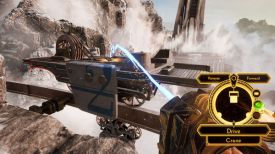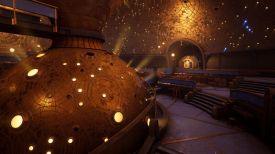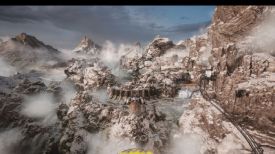Firmament
Cyan Worlds Inc.
I
am a Cyan fan, Riven being the game that really sold me on adventure
games. I have played all the ones that came after, enjoyed some more
than others, and seven years after the last outing (Obduction) we have
this.
Not surprisingly, you wake (this time from a mechanical pod) to find
yourself in a room. An ‘avatar’ appears, telling you that she is dead
but was once like you, a clean canvas and a blank mind. She says you
are a Keeper, as was she, as they all were, and she will be your Mentor
and teach you.
She also says she will lie to you.
She then gives you your Adjunct, a gauntlet-like apparatus that will be
the way you interact with the world. Take it, and off you go.
Three realms/worlds await. Each is different; Curievale being all ice
and snow, St. Andrew being lush and green, and Juleston being coastal
and almost in between. Yet there is a similarity about what is within
each world, in terms of your ultimate goals.
You will also visit The Swan, essentially a transport lounge that is
your hub to and from the other realms. A glittering brass contraption in
the centre of the room suggests something more.
There is a steampunk aesthetic about each location. Large machines, and
even larger mechanisms abound, and playing with some in order to
activate others is a recurring activity. You get an early taste once you
leave the starting location; a large crane capable of lifting massive
blocks of ice awaits.
It
is a reasonably open game in terms of where you can go and when, but the
need to upgrade your Adjunct will mean there are conundrums that you
might encounter that can’t be solved until you have achieved a
particular upgrade. I never felt constrained though, as if I was being
pushed down a particular path, and the sense of boundless exploration
was prevalent throughout.
It
was helped by the ability to ‘go anywhere’ as you move about, as well as
the 360-degree ability to look at everything. The WASD keys propel your
first person perspective, while a combination of the keyboard and mouse
is used to interact with the environment, and all those things taken
together create a feeling of immersion in the gaming environment.
It
is a sumptuously detailed game, but it is also somewhat ‘flat.’ There is
very little motion in the background environments, which creates a
degree of artificiality inconsistent with these being real worlds. The
St Andrew realm is probably the one that suffers the most, its foliage
just sitting there like a bunch of fake plants. Turning the foliage
setting up to ‘epic’ added volume but no movement. Which doesn’t detract
from the richness of the graphics, but does impact how that richness
affects you.
When movement does occur though it can be impressive. Pennants flutter
gently, and even within the broader excellent shadow effects, the shadow
the pennant casts stopped me in my tracks the first time I noticed.
Similar is the degree of interactivity with the detritus of people being
here before that you come across, especially in The Swan. You will see
lots of little bits and pieces, but you can look but not touch. You
don’t pick things up, open cupboards, search through items etc. A few
notes and books can be picked up, but otherwise its hands off throughout
the game. Which on reflection is consistent with the earlier games, so
perhaps I shouldn’t have wanted more. But there were times I did,
largely a product of the amount of stuff that I wished I could play with
(which is a further plus in its own right).
You do though get to go on rides, sweeping across the vista of the
particular realm. Whilst maybe not as exhilarating as those in some of
the previous games (I can distinctly remember showing a friend the first
ride in Riven and they went and bought the game), they can’t be
dismissed lightly.
Then there is the large insect-like Camelus that you get to drive. Maybe
just play around in it for a while before tackling the related
conundrum.
The Cyan sense of ‘what do I need to do here/what does the realm want
from me/how do I make it happen’ is present throughout. You will find
limited insights in e.g., diagrams on the wall and perhaps the word of
the Mentor in your ear (she comes and goes throughout) but fiddling and
observing and fiddling some more is your stock in trade. Pull that, poke
that, move that, watch and (hopefully) learn. Then do it again.
That aspect played to my strengths. I like having to work out the ‘what’
of a conundrum before having to work out the ‘how.’ If you are the same,
there is a lot to like here. That it tends to play out on a broad
canvass is all the more enticing.
You might argue that there is a sameness about the things you do in each
realm. The big objectives are the same, and achieving them
involves stuff somewhat the same. Simplistically, move this/these things
to access over there; e.g., rotate and raise and lower gardens, shunt
and raise and lower a series of sleds, rotate and lower and raise and
lift stuff with a crane, all to be able to get somewhere else.
I
wouldn’t argue that. I accept the big objectives are the same, but the
other stuff occurs in a context that made it feel different. The
mechanics might be similar, but the engagement with the conundrum is
not. At least not to me.
I
mentioned the Adjunct, and it warrants some further attention. It
connects to sockets, which is how you make everything happen. Drive
this, turn on that, power that up. Want to go up in that lift? Use the
socket to call it to come down, and then once inside, use the other
socket to make it go up. Want to rotate that crane? Tether into the
relevant socket and have at it.
Sockets are key. Fail to find them at your peril. Many are obvious, some
are not. Be willing to explore a particular environment to identify them
all, to be sure you can ultimately achieve the immediate objective.
Learn the nuances of operating them as you go, including tethering
around corners.
I
think its easier than some of the previous games – I didn’t take copious
notes or have to learn a number system – but easier is a relative
concept, and I was lost at times in terms of ‘what now.’ The openness
meant I could go elsewhere to see whether that would help, or just to do
something else and come back refreshed. I was motivated to explore and
ponder and do it all again, which didn’t mean I didn’t access a
walkthrough here and there.
There is very limited spoken word, mainly because there is no-one to
interact with. Mentor whispers in your ear, announcements play over a
public address system, and the twist in the endgame has another voice.
The ambient sound however is as polished as you would want, and a
soundtrack rounds things out.
You can sort out for yourself what you think of the story. I reckon it
neither enhanced nor detracted from my exploratory endeavours. I did
think though that it relied too heavily on exposition.
You can save at will and the game will autosave as well. You can tweak
numerous settings, particularly in the graphics tab, which can help it
run on borderline specifications. It took me about 15 hours, and I
thoroughly enjoyed each one of them.
I played on:
OS: Windows
10, 64 Bit
Processor:
Intel i7-9700K 3.7GHz
RAM: Corsair
Dominator Platinum RGB DDR4 32GB
Video card:
AMD Radeon RX 580 8192MB
GameBoomers Review Guidelines
June 2023
design copyright© 2023
GameBoomers
Group






